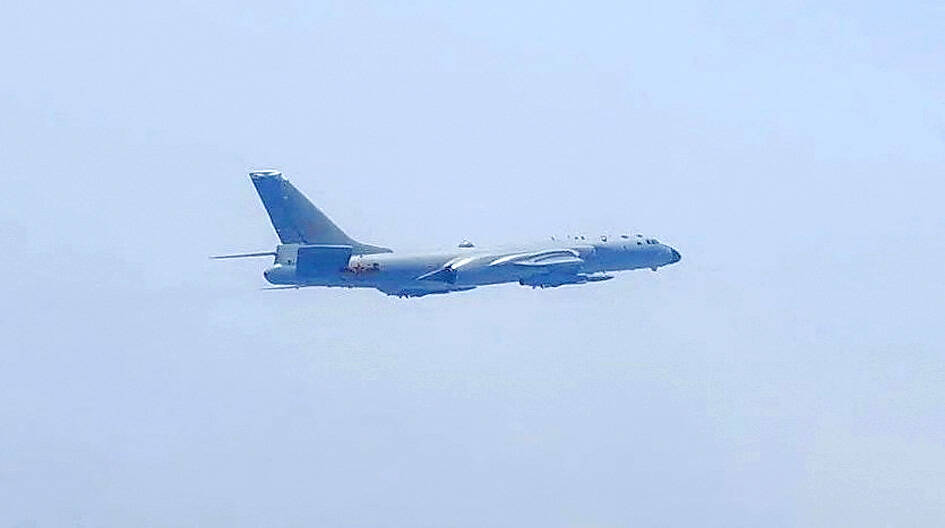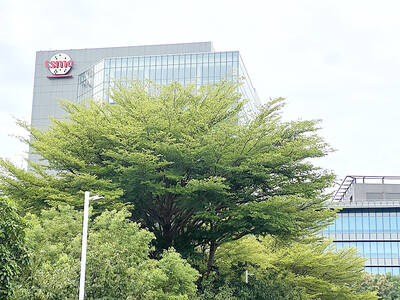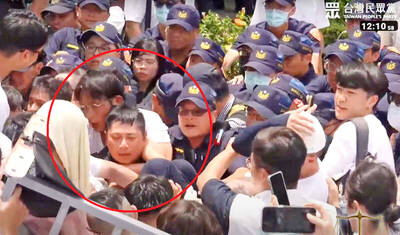More than 30 Chinese warplanes entered Taiwan’s air defense identification zone (ADIZ) over the course of about six hours, the Ministry of National Defense said yesterday in a rare, second morning update.
From 5am yesterday, “a total of 37 Chinese military aircraft” entered Taiwan’s southwestern ADIZ, ministry spokesman Sun Li-fang (孫立方) said.
“Some continued ... toward the western Pacific for long-range reconnaissance training,” Sun said at about 11am.

Photo: REUTERS
They included J-11 and J-16 fighters, Xian H-6 bombers, YU-20 tanker aircraft, and airborne early warning and control system aircraft, the ministry wrote on Twitter.
While not the largest number of incursions this year — which was 45 sorties on April 9 — yesterday’s surge occurred over a much more compressed time frame.
The military is “monitoring the situation closely,” the ministry wrote, adding that patrol planes, naval vessels and land-based missile systems had been dispatched.
The announcement followed a regular morning update on Chinese People’s Liberation Army activity near Taiwan, which said that 12 aircraft — one of which crossed the median line of the Taiwan Strait — and four navy vessels were detected in the 24 hours ending at 5am yesterday.
The incursions came a day after the US, the Philippines and Japan completed their first-ever joint coast guard drills in the South China Sea.

FIREPOWER: On top of the torpedoes, the military would procure Kestrel II anti-tank weapons systems to replace aging license-produced M72 LAW launchers Taiwan is to receive US-made Mark 48 torpedoes and training simulators over the next three years, following delays that hampered the navy’s operational readiness, the Ministry of National Defense’s latest budget proposal showed. The navy next year would acquire four training simulator systems for the torpedoes and take receipt of 14 torpedoes in 2027 and 10 torpedoes in 2028, the ministry said in its budget for the next fiscal year. The torpedoes would almost certainly be utilized in the navy’s two upgraded Chien Lung-class submarines and the indigenously developed Hai Kun, should the attack sub successfully reach operational status. US President Donald Trump

Taiwan Semiconductor Manufacturing Co (TSMC, 台積電) is expected to start construction of its 1.4-nanometer chip manufacturing facilities at the Central Taiwan Science Park (CTSP, 中部科學園區) as early as October, the Chinese-language Liberty Times (the Taipei Times’ sister newspaper) reported yesterday, citing the park administration. TSMC acquired land for the second phase of the park’s expansion in Taichung in June. Large cement, construction and facility engineering companies in central Taiwan have reportedly been receiving bids for TSMC-related projects, the report said. Supply-chain firms estimated that the business opportunities for engineering, equipment and materials supply, and back-end packaging and testing could reach as high as

ALL QUIET: The Philippine foreign secretary told senators she would not respond to questions about whether Lin Chia-lung was in the country The Ministry of Foreign Affairs on Wednesday confirmed that a business delegation is visiting the Philippines, but declined to say whether Minister of Foreign Affairs Lin Chia-lung (林佳龍) is part of the group, as Philippine lawmakers raised questions over Lin’s reported visit. The group is being led by Deputy Minister of Agriculture Huang Chao-chin (黃昭欽), Chinese International Economic Cooperation Association (CIECA) chairman Joseph Lyu (呂桔誠) and US-Taiwan Business Council (USTBC) vice president Lotta Danielsson, the ministry said in a statement. However, sources speaking on condition of anonymity said that Lin is leading the delegation of 70 people. Filinvest New Clark City Innovation Park

TPP RALLY: The clashes occurred near the Chiang Kai-shek Memorial Hall on Saturday at a rally to mark the anniversary of a raid on former TPP chairman Ko Wen-je People who clashed with police at a Taiwan People’s Party (TPP) rally in Taipei on Saturday would be referred to prosecutors for investigation, said the Ministry of the Interior, which oversees the National Police Agency. Taipei police had collected evidence of obstruction of public officials and coercion by “disorderly” demonstrators, as well as contraventions of the Assembly and Parade Act (集會遊行法), the ministry said in a statement on Sunday. It added that amid the “severe pushing and jostling” by some demonstrators, eight police officers were injured, including one who was sent to hospital after losing consciousness, allegedly due to heat stroke. The Taipei